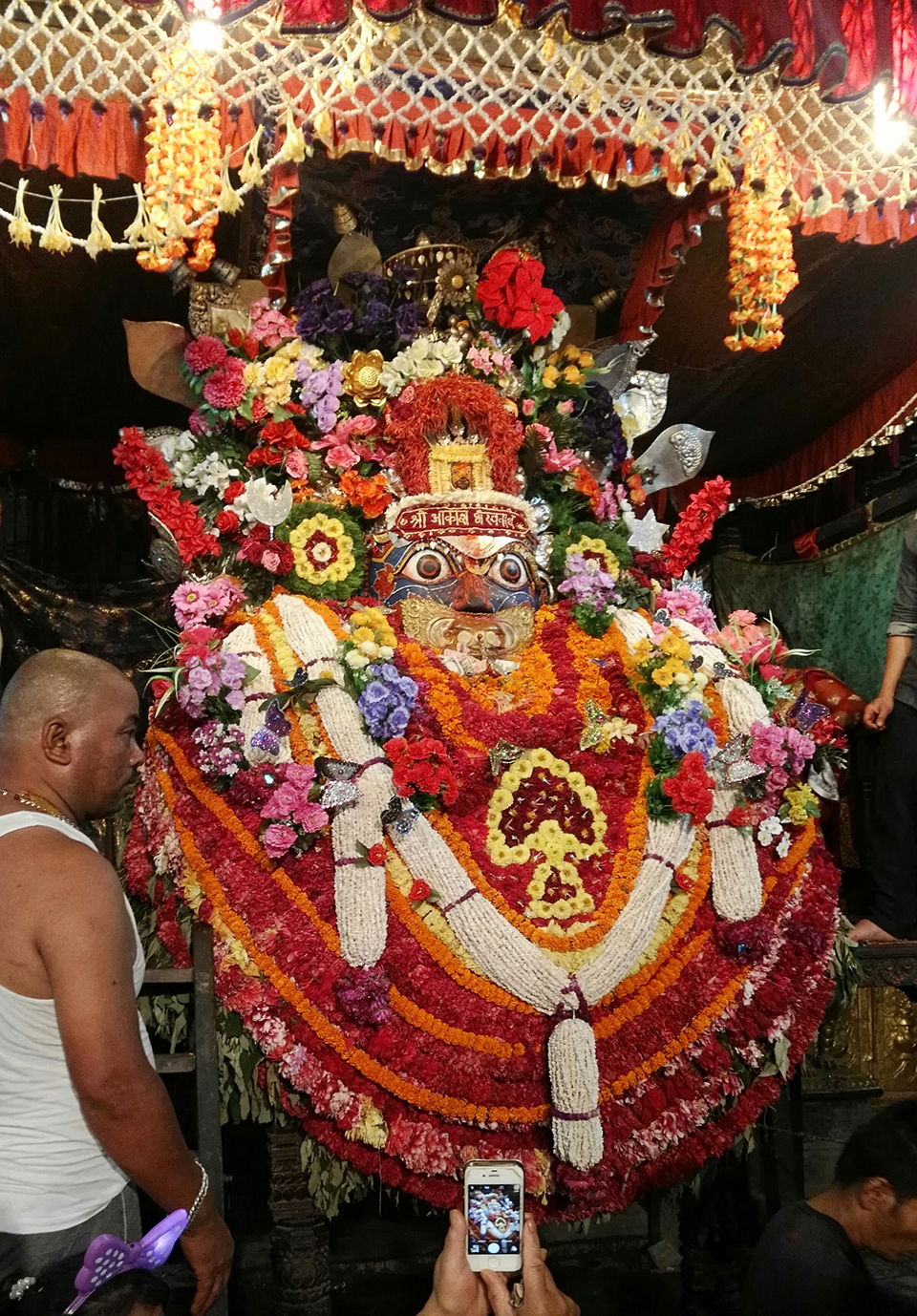
OR

With the grounds of grievances and resentment still intact, the possibility of further uprisings in Madhes can never be ruled out.
It was an afternoon of autumnal rain on 9/11, 2015 in Jaleshwar. Still, in her early forties, Ramshila Mandal probably didn’t want to be drenched and become a spectacle for gawking onlookers. But instead of taking shelter below the eaves of a beauty parlor near the temple of Jaleshwarnath, she should have perhaps risked experiencing what DH Lawrence calls “… of all the pain / here to us given: / finely divisible / falling as rain.” Before she could avert her gaze from the melee in the street, she was shot dead by the security forces with a bullet hole between her eyes.
Septuagenarian Ganesh Chaudhari was killed while returning from the marketplace. In nearby Janakpur, Dilip Yadav, 13, was killed on the bank of a pond. Nitu Yadav, just turned 14, was shot dead from close range. In a meticulously researched report published soon after the ruthless police crackdown in Madhes, the Human Rights Watch asserted that it “... found no evidence that any of these victims, including the police, was posing a threat to another at the time he were killed.”
The threat, it appears, was being felt elsewhere. The PEON decided that heavens would certainly fall if a constitution of whatever kind was not promulgated through the ‘fast-track’ by seizing the ‘golden opportunity’ offered by the Gorkha Earthquakes. In the handbook of hegemony, a crisis is too good an opportunity to further entrench the existing order to let it pass unutilized. The Gorkhali supremacists of Hindu, Aryan, Male and Nepali Speaking (HAMNS) variety had never placed much value upon human life anyway. Free of any family relation or ethnic connection with Madhesis, security forces fired bullets with gay abandon in Madhes.
The story is apocryphal but succeeds in portraying the mindset of the Gorkhali ruling elite. It is said that the-then Deputy Prime Minister and Home Minister in the autumn of 2015, who took his instructions from his party chief rather than the Prime Minister of the coalition government, had given clear instructions to security forces to shoot as many protesters as necessary so that Madhesis will not have the courage to raise their heads again. Ultimately, the political determination of the PEON won the day.
A divisive constitution was finally promulgated on September 20, 2015, to fireworks and lighting of lamps in the hills and mountains even as most of Madhes observed a voluntary blackout. The public memory is phenomenally short. The Madhesbadi parties that spearheaded protests against the draft constitution and were witness to the excesses of ‘9/11 in Madhes’ are taking part in a local election being held in the month of September under the very same statute that they were opposing tooth and nail until quite recently.
Sans oarsman
Having traversed through the ranks of CPN-UML and the Maoists, Upendra Yadav had emerged as a firebrand of national standing after the First Madhesh Uprising in 2007 as he had succeeded in mobilizing dormant masses through fiery rhetoric delivered in chaste Hindi or labored Nepali. Ambitious Madhesi politicos of all colors gravitated towards Yadav in the hope of a secure future. The Second Madhesh Uprising in 2008 established Mahanth Thakur, a morally upright and soft-spoken leader of Nepali Congress, as the centrist campaigner of Madhesi and Tharu dignity. He attracted jaded politicians repentant of their past.
While Yadav had drawn strength from his followers, Thakur was a source of inspiration to his horde. In an attempt to cut Yadav down to size after his outright casteist role in the first presidential election, various domestic and foreign forces engineered multiple divisions in his party. It was much easier to diminish the influence of Thakur since he had refused to compromise in order to win an election. By the second Constituent Assembly, both camps had politically exhausted themselves. Rajendra Mahato was still around, but he lacked elite credibility and mass appeal. After CA II elections, Madhes was restive but didn’t know how to express its frustrations. The 16-Point Conspiracy and the Draft Constitution ignited the popular revolt.
The Third Madhesh Uprising, however, floundered from the beginning as it failed to produce a captain capable of charting a safe course in the choppy waters of competing geopolitical forces. But with the ground of grievances and resentment still intact and salt being rubbed on fresh wounds in the name of elections without constitutional amendments, possibility of further uprisings in Madhes can never be ruled out.
It’s in the nature of geopolitics that it changes without advance notice. The all-powerful Soviet Union collapsed like a house of cards. Sometimes leaders emerge out of nowhere. In the early-1990s, nobody had heard of Pushpa Kamal Dahal and Khadga Prasad Sharma Oli was somewhat sickly functionary of a party completely out of tune with the trends of the time. Perhaps it’s too early to write off Madhes. In the mean time, future Madhesi leaders need to learn from the failure of Janjati protests to ever take off despite relentless attempt of some of its committed campaigners.
Among the Janjatis, the Gurungs were perhaps the first to be completely mainstreamed into the Gorkhali scheme of things. The Jhapalis of 1970s mobilized Rais and Limbus of eastern mountains and then turned them into robotic conformists of the nationalistic storyline of ‘abhor India and ‘despise Madhesis’ rhetoric of hate. The Maoists concentrated on Magars and Tharus and used both communities to great advantage. Purpose of the HAMNS supremacists served—transformation of a Chhetri Monarchy into a Bahun Oligarchy in the name of the republic—they were discarded like sullied mop-rags.
Individual Magar leaders have been given some sops even though the community as a whole has been denied self-rule, but Tharus have been dismissed with utter contempt. It’s not just Madhesis; no leader appears on the Janjati horizon who can take up the unfulfilled agenda of the restructuring of the state with courage and conviction.
Broken backbone
The history of Nepal has been revised so often by succeeding hagiographers of different rulers that it’s almost impossible to sift wheat from the chaff in the bountiful harvest of competing narratives. However, no matter how the event is portrayed, almost all historians agree that the chieftain of the Gorkhali forces seized the Malla kingdom of Kathmandu in September 1768 on the day of Indra Jatra by stealth and declared himself the new king.
Prior to their carefully planned incursion, Gorkhalis had imposed a crippling blockade on the Nepal Valley that had sapped the energy of its residents. Hoping for a respite from their endless suffering, inhabitants of the valley embraced their new rulers with a combination of expectation and desperation. Worst fears of Newars soon began to come to pass as the Gorkhali elite started tightening its stranglehold over the economy, politics and culture of the valley.
The ethnic elite is almost always the first to change their loyalty. After the Gorkhali takes over, many Malla nobles changed their surname to Pradhananga to escape the wrath of victors. After the dust had settled post-1769 Gorkhali consolidation, courtiers of erstwhile Malla rulers reconciled themselves to the Shah Rule. The Newar aristocracy appealed to the supposed generosity and kindness of the Hindu king of Asali Hindusthana. The Buddhist traders learned to appease new rulers by presenting lavish gifts, pledging fealty to the crown, and promising to share their earnings from lucrative Indo-Tibetan trade. The laity had to bear the cost of invasion and beg for relief.
The Shah victory had been bad enough for the self-esteem of Newars, even the possibility of assertion of dignity was crushed forever when a Khas desperado laid the foundation of Ranarchy in the wake of Kot Parva of September 1846 and subsequent collapse of Newar collaborators of existing Gorkhali elite. These days, roots of what one calls Newar resilience lie in a combination of feeling that characterizes most marginalized people everywhere—self-preservation despite anger, anxiety, paranoia, fear, depression, self-blame, sadness, frustration, hopelessness, resentment, powerlessness, self-doubt, isolation, stress, confusion and fear of invisibility on the national stage.
Madhesis have much less intellectual and material resources than Newars of Kathmandu valley. It has taken Gorkhalis two-and-half centuries to confine inheritors of the most refined culture of South Asia into living museums like Bhaktapur or touristic spectacles at luxury hotels. Worse fate awaits Madhes if a new generation of Madhesis can’t get their act together. Elections are clearly divertissements to shift attention away from fundamental constitutional issues to restore dignity of all Nepalis.
You May Like This

Lady Gaga documentary to release in September
LOS ANGELES, August 26: ‘Gaga: Five Foot Two’, a portrait of a year in the life of pop star Lady Gaga,... Read More...

Talent show of differently abled in September
KATHMANDU, July 18: An event called ' differently abled idol-2016' is to be organized for the first time in the... Read More...

Dharma Shree bodybuilding tournament in September
KATHMANDU, July 8: Nepal Byayam Mandir is set to hold the 14th Dharma Shree Nation-wide Open Bodybuilding Tournament on September... Read More...




Just In
- Govt receives 1,658 proposals for startup loans; Minimum of 50 points required for eligibility
- Unified Socialist leader Sodari appointed Sudurpaschim CM
- One Nepali dies in UAE flood
- Madhesh Province CM Yadav expands cabinet
- 12-hour OPD service at Damauli Hospital from Thursday
- Lawmaker Dr Sharma provides Rs 2 million to children's hospital
- BFIs' lending to private sector increases by only 4.3 percent to Rs 5.087 trillion in first eight months of current FY
- NEPSE nosedives 19.56 points; daily turnover falls to Rs 2.09 billion
















Leave A Comment